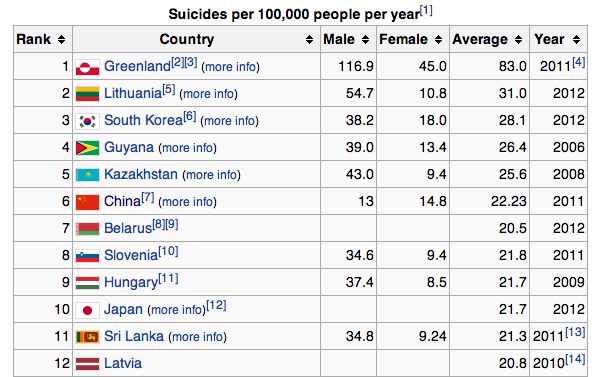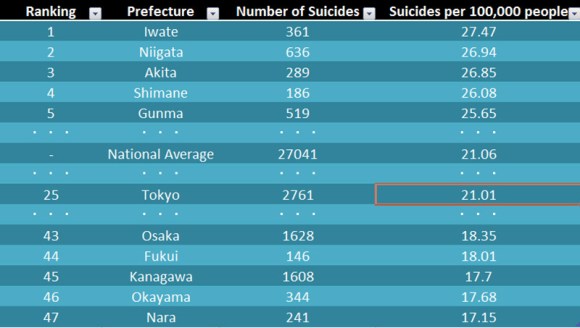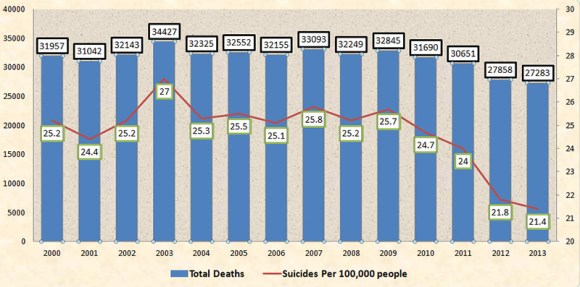
Live in urban Japan long enough and, as shocking as it sounds, you’re eventually going to have the distinctly unpleasant experience of riding a train that hits and more than likely kills a human being.
Even if you aren’t experiencing it firsthand, walking into a Tokyo train station only to notice yet another train delay caused by what is euphemistically described as a “bodily accident” (jinshin jiko, or 人身事故) is at least a weekly occurrence. It’s enough to make you think Japan must be wrestling with one hell of a suicide problem.
Which is true. But it’s not quite as bad as the Western media would have you believe. Here are five facts about suicide in Japan that are about as uplifting as we have any right to expect from facts about suicide:
1) Japan isn’t the suicide capital of the world.
While Japan has been the world leader in suicides in the past, that distinction currently belongs to Greenland, where an average of 83 out of 100,000 people took their own lives in 2011, according to the World Health Organization (WHO). Japan averaged 21.4 in 2013, the most recent year with available data.
2) Japan’s suicide capital isn’t Tokyo.
Despite the city’s frequent portrayal as a cold, unfeeling megalopolis filled with lonely, financially burdened salarymen who are all constantly just this shy of offing themselves, Tokyo isn’t actually Japan’s suicide capital. While it certainly has the highest number of suicides by virtue of its staggering population, Iwate Prefecture in the northeast recorded the highest rate at 27.5 suicides per 100,000 people in 2013.
3) “Train Jumpers” are surprisingly rare.
The overwhelming majority of suicides in Japan are by hanging, according to WHO. Going by some admittedly old data (2003), only 2.1% of male suicides and 3.6% of female suicides were death by train strike. Overdoses, hangings, and even jumping off of buildings and deliberate drowning were more common methods in that same year.
4) Rates are declining.
We just recently talked about how suicides in general in Japan are on the decline in recent years. While suicide is still far and away the leading cause of death among youths in Japan, that statistic actually isn’t as scary as it seems on the surface; with Japan’s low rate of violent crime and death by natural causes unsurprisingly low in that age group, the numbers speak more to Japan’s overall safety than to any kind of disturbing suicide trend.
5) The reasons are pretty much what you’d expect.
While there are certainly “shame culture” aspects to Japan’s high suicide rate, people are generally killing themselves for the reasons you’d probably expect any other place: Financial trouble and heartbreak. Divorce, debt and bankruptcy are some of the most common reasons for suicide in Japan.
So, there you have it. Rest assured that Japan’s relationship with suicide isn’t as unhealthy as you’ve probably heard. Still, all this talk of prematurely buying the farm has left me in dire need of some adorable cat pictures.
Source: Madame Riri
Feature Photo: Wikipedia – ajari




 Japan’s suicide number drops for eighth straight year, rises among teens
Japan’s suicide number drops for eighth straight year, rises among teens 2014 suicide rates in Japan down, suicide in men still twice that of women
2014 suicide rates in Japan down, suicide in men still twice that of women 16 facts about India that will blow your mind
16 facts about India that will blow your mind Rubbernecking gone too far? Net users react to crowds taking pics of train hit by suicide jumper
Rubbernecking gone too far? Net users react to crowds taking pics of train hit by suicide jumper Is Pokémon Go helping prevent deaths at one of Japan’s most notorious suicide spots?
Is Pokémon Go helping prevent deaths at one of Japan’s most notorious suicide spots? Red light district sushi restaurant in Tokyo shows us just how wrong we were about it
Red light district sushi restaurant in Tokyo shows us just how wrong we were about it Sandwiches fit for a sumo served up in Osaka【Taste Test】
Sandwiches fit for a sumo served up in Osaka【Taste Test】 McDonald’s new Happy Meals offer up cute and practical Sanrio lifestyle goods
McDonald’s new Happy Meals offer up cute and practical Sanrio lifestyle goods Japanese ramen restaurants under pressure from new yen banknotes
Japanese ramen restaurants under pressure from new yen banknotes Tokyo Tsukiji fish market site to be redeveloped with 50,000-seat stadium, hotel, shopping center
Tokyo Tsukiji fish market site to be redeveloped with 50,000-seat stadium, hotel, shopping center Akihabara pop-up shop sells goods made by Japanese prison inmates
Akihabara pop-up shop sells goods made by Japanese prison inmates We tried Korea’s way-too-big King Tonkatsu Burger at Lotteria 【Taste Test】
We tried Korea’s way-too-big King Tonkatsu Burger at Lotteria 【Taste Test】 French Fries Bread in Tokyo’s Shibuya becomes a hit on social media
French Fries Bread in Tokyo’s Shibuya becomes a hit on social media Beautiful Ghibli sealing wax kits let you create accessories and elegant letter decorations【Pics】
Beautiful Ghibli sealing wax kits let you create accessories and elegant letter decorations【Pics】 Beautiful Red and Blue Star luxury trains set to be Japan’s new Hokkaido travel stars
Beautiful Red and Blue Star luxury trains set to be Japan’s new Hokkaido travel stars All-you-can-drink Starbucks and amazing views part of Tokyo’s new 170 meter-high sky lounge
All-you-can-drink Starbucks and amazing views part of Tokyo’s new 170 meter-high sky lounge More foreign tourists than ever before in history visited Japan last month
More foreign tourists than ever before in history visited Japan last month Studio Ghibli releases new action figures featuring Nausicaä of the Valley of the Wind characters
Studio Ghibli releases new action figures featuring Nausicaä of the Valley of the Wind characters New private rooms on Tokaido Shinkansen change the way we travel from Tokyo to Kyoto
New private rooms on Tokaido Shinkansen change the way we travel from Tokyo to Kyoto Starbucks reopens at Shibuya Scramble Crossing with new look and design concept
Starbucks reopens at Shibuya Scramble Crossing with new look and design concept Studio Ghibli glasses cases let anime characters keep an eye on your spectacles
Studio Ghibli glasses cases let anime characters keep an eye on your spectacles Studio Ghibli releases Kiki’s Delivery Service chocolate cake pouches in Japan
Studio Ghibli releases Kiki’s Delivery Service chocolate cake pouches in Japan New definition of “Japanese whiskey” goes into effect to prevent fakes from fooling overseas buyers
New definition of “Japanese whiskey” goes into effect to prevent fakes from fooling overseas buyers Our Japanese reporter visits Costco in the U.S., finds super American and very Japanese things
Our Japanese reporter visits Costco in the U.S., finds super American and very Japanese things Studio Ghibli unveils Mother’s Day gift set that captures the love in My Neighbour Totoro
Studio Ghibli unveils Mother’s Day gift set that captures the love in My Neighbour Totoro New Japanese KitKat flavour stars Sanrio characters, including Hello Kitty
New Japanese KitKat flavour stars Sanrio characters, including Hello Kitty New Pokémon cakes let you eat your way through Pikachu and all the Eevee evolutions
New Pokémon cakes let you eat your way through Pikachu and all the Eevee evolutions Disney princesses get official manga makeovers for Manga Princess Cafe opening in Tokyo
Disney princesses get official manga makeovers for Manga Princess Cafe opening in Tokyo Sales of Japan’s most convenient train ticket/shopping payment cards suspended indefinitely
Sales of Japan’s most convenient train ticket/shopping payment cards suspended indefinitely Sold-out Studio Ghibli desktop humidifiers are back so Totoro can help you through the dry season
Sold-out Studio Ghibli desktop humidifiers are back so Totoro can help you through the dry season Japanese government to make first change to romanization spelling rules since the 1950s
Japanese government to make first change to romanization spelling rules since the 1950s Ghibli founders Toshio Suzuki and Hayao Miyazaki contribute to Japanese whisky Totoro label design
Ghibli founders Toshio Suzuki and Hayao Miyazaki contribute to Japanese whisky Totoro label design Doraemon found buried at sea as scene from 1993 anime becomes real life【Photos】
Doraemon found buried at sea as scene from 1993 anime becomes real life【Photos】 Tokyo’s most famous Starbucks is closed
Tokyo’s most famous Starbucks is closed One Piece characters’ nationalities revealed, but fans have mixed opinions
One Piece characters’ nationalities revealed, but fans have mixed opinions We asked a Uniqlo employee what four things we should buy and their suggestions didn’t disappoint
We asked a Uniqlo employee what four things we should buy and their suggestions didn’t disappoint Princesses, fruits, and blacksmiths: Study reveals the 30 most unusual family names in Japan
Princesses, fruits, and blacksmiths: Study reveals the 30 most unusual family names in Japan Two men die in apparently separate suicides after jumping in front of the same train
Two men die in apparently separate suicides after jumping in front of the same train The number of suicides among Japanese citizens jumped in August, worrying officials
The number of suicides among Japanese citizens jumped in August, worrying officials Microsoft pulls game inspired by Logan Paul’s infamous suicide forest video from Xbox Store
Microsoft pulls game inspired by Logan Paul’s infamous suicide forest video from Xbox Store Japanese Twitter reacts to Logan Paul’s “Japanese Suicide Forest” video
Japanese Twitter reacts to Logan Paul’s “Japanese Suicide Forest” video Devoted David Bowie fan in Japan attempts to commit suicide following rock legend’s death
Devoted David Bowie fan in Japan attempts to commit suicide following rock legend’s death Woman kills self jumping onto train tracks, delay causes conductor to jump off tracks at other station
Woman kills self jumping onto train tracks, delay causes conductor to jump off tracks at other station 16 facts about China that will blow your mind
16 facts about China that will blow your mind Chinese couple’s suicide attempt leads to serious injury, criminal charges, and $24,000 in damages
Chinese couple’s suicide attempt leads to serious injury, criminal charges, and $24,000 in damages Man hangs himself outside of Japan’s busiest train station
Man hangs himself outside of Japan’s busiest train station Crazy-cheap Japanese apartment for less than 140 bucks a month comes with headaches every day
Crazy-cheap Japanese apartment for less than 140 bucks a month comes with headaches every day Japanese subway ad about depressed teens should probably be in a different place
Japanese subway ad about depressed teens should probably be in a different place Parents of bullied teenage girl who committed suicide commission portrait to “attend” Seijinshiki
Parents of bullied teenage girl who committed suicide commission portrait to “attend” Seijinshiki World War II ended 70 years ago — here’s the planned US invasion of Japan that never happened
World War II ended 70 years ago — here’s the planned US invasion of Japan that never happened Terrace House season cancelled, removed from streaming service after Hana Kimura’s death
Terrace House season cancelled, removed from streaming service after Hana Kimura’s death Terrorists release third video of Japanese hostage, say it will be his last
Terrorists release third video of Japanese hostage, say it will be his last
Leave a Reply